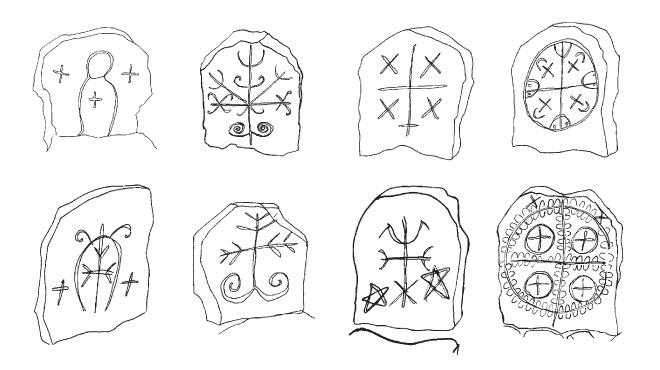Types of mirilo
Several days or months aft er the ceremony, the architectural formation of the mirilo is carried out in the dry-stone technique. Local craftsmen who were skilled in stone carving did this. If the family could not pay for such workmanship, then the carving was carried out by a member of the clan, simply and rustically.
At the spot of the two stones that measured the deceased, carved upright stone slabs were placed (headstone and footstone) of various types: arched-rounded, two-eaved (“rooft op”), rectangular, square, amorphous, or a naturally formed slab. The area between them was paved with slabs of different lengths but the same width. The same form can also be seen among some actual graves in the cemeteries of the region beneath the Velebit, and these were placed in these cemeteries up to the seventies of the 20th century.
Such an architectural form of the mirilo convincingly preserves the authentic conception of the deceased for all future generations.

Decorations – “folk markings” and inscriptions
The decorations and symbols were carved on the headstone, and more rarely on the footstone or the slab next to the headstone. The iconographic motifs represent the traditional symbolic signs and marks that extend from as far back as the prehistoric period in the Velebit. Astral, magical, and mythic beliefs were widespread, particularly the worship and summoning of the Sun (“Oh Great Sun help us, my Brilliant Sun accept my fervent thanks for your help... help my soul and all of our souls” – This statement was recorded from the local inhabitant Pero Jović in the 20th century and Josip Matak at the beginning of the 21st century). For this reason, the motif of the sun disc is the most frequent iconographic motif, displayed in diverse variants (spiral-volute, rosette, rayed circle, cross in a circle, swastika). These motifs represent symbols of the “eternal life”. The cross as a different symbol was also displayed in variants, from simple geometric forms to anthropomorphic shapes. A combination of magic, myth, and religion can be perceived in the decorations, although with time they have evolved into decoration and become the “folk markings” oft en seen on objects of everyday use throughout the Velebit.
Epigraphy appeared on the headstones from the 18th century. It usually consists of the first and last name of the deceased, and the years of birth and death. Sometimes only the initials are carved and the year of death with the epitaph “May God have mercy” (the Tribanj - Kozjač mirilo stones). Some inscriptions are worn and illegible (the Nadkruškovac mirilo stones) or they are legible, but cannot be deciphered (the Samardžić - Jusup mirilo stones).